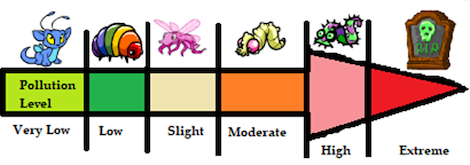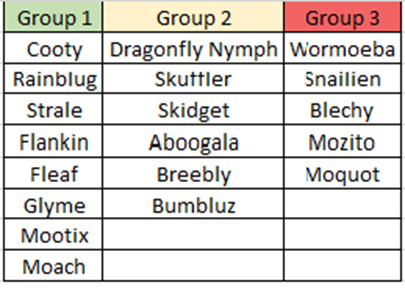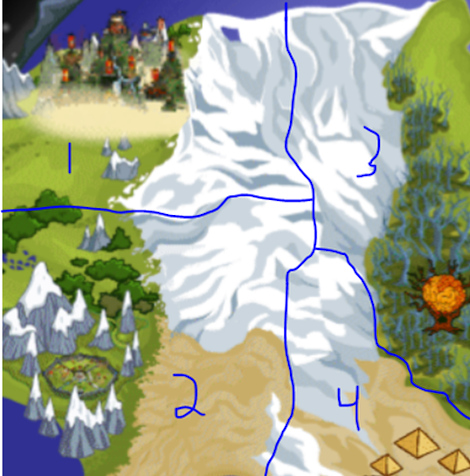 Neopian Water Wonders
by parody_ham
--------
Happy Petpet Day! Let’s take a deep dive into the fascinating world of the pets of our Petpets: Petpetpets! Welcome to another edition of "Science with the Seekers," where scientists from around Neopia share their expertise with the world. Today, we have a special guest from Maraqua College, Dr. Lohreli, who is the leading expert in freshwater Petpetpet (henceforth called P3) biology. What does the study of freshwater P3 biology entail and how does it differ from saltwater biology? Freshwater biology is an offshoot of aquatic biology, one that focuses on streams, rivers, lakes, and other non-saline waters. Nutritional resources often come from land run-off but can also originate from erosion, the air, or even precipitation. Many species of P3 cannot tolerate high levels of salt, with a few thriving in brackish or semi-salty, tidal conditions. In the open oceans, most of the food chain begins with small, photosynthetic plankton that take carbon dioxide and transform it into food. These systems depend on a process called upwelling, where seasonal changes in wind patterns force the top layer of water away from the shoreline and out to sea, replacing it with nutrient-dense waters. Critical nutritional building blocks such as Nitrogen and Phosphorous mix most readily in spring and can fuel what we call "phytoplankton blooms." Many species of fish eaten in Maraqua or Krawk Island depend on this annual refreshment of resources, as the abundance of primary production means enough food for the rest of the food chain. Some Petpets, such as Walein and Peadackle, time their migration around the spring bloom. A recent surge in ecotourism has blossomed from this phenomenon as Neopians from all around the world gather in boats to watch the spectacle of migration and mass-feeding events. What are "Freshwater Macroinvertebrates?" Loosely, macroinvertebrates are Petpetpets (and in some cases, like the Crabula, Petpets) that lack a backbone and can be seen with the unaided eye. A majority have a long-term aquatic stage (upwards to five years) before becoming flighted adults. They depend on high oxygen levels and process the water through specialized gills. As they are living long-term in the water, they are also exposed to any of the pollution issues that are plaguing the system. How can we use Macroinvertebrates as "indicator species?" Think of an indicator species as a Weewoo in a coal mine. When spelunking Weewoo become agitated or lethargic, there is insufficient oxygen in the cave. The same can be said of macroinvertebrates as the presence or absence of an indicator species is used to infer habitat quality. Some species of P3s are extremely sensitive to pollution and will only be found in the most pristine water bodies. Other P3s are very tolerant to pollution. In the most extreme cases, no life will be present due to the harshness of the habitat. See Figure 1 for a visual representation of variable sensitivity.
 Figure 1. Pollution Tolerance Levels of Petpetpets Maraqua College has developed a technique to study comparative water quality called "CMS" or the % of Cooties, Moach and Strale found in a sample. All three of these P3s are very sensitive to pollution, and are only found in water bodies with low levels of pollution. If there is a large percentage of these three P3s in the sample, it is considered high-quality water. We can further break down P3s into three general categories: Group 1, Group 2, and Group 3. Group 1 are the most sensitive to pollution, Group 2 is in the middle or has variable sensitivity, and Group 3 is the most tolerant of pollution. Bear in mind that there are additional species beyond this basic table, and that aquatic Petpets are also impacted by the water quality.
 Table 1. Petpetpet Pollution Tolerance Groups Bear in mind that collecting Group 3 Petpetpets in a sample does not necessarily indicate poor water quality. If pollution tolerant P3s are joined by a diverse assortment of other P3s (notably the more sensitive taxonomic groups) then that is an indication of a healthy ecosystem. Said another way, optimal system efficiency is best achieved when a host of different species offer varied ecological function. Each species of P3 has a role to play in this matrix. Some species, like the Fleaf, break apart organic material into smaller parts, while others, like the Flankin, function as a P3 predator. When enough cogs are missing, the machine begins to shut down and diversity can grind to a halt. If one of these species is an "ecosystem engineer," this pattern is even more noticeable. An ecosystem engineer is a species that has a large impact on the physical features of the habitat. Glyme slime is known to aid in the growth of submerged aquatic vegetation, thus accelerating the habitability of ponds and lakes. They also release oxygen into the water through their chloroplasts as they act as both autotroph (self-feeders) and heterotroph (obtain nutrients by eating other plants or animals). Without Glyme, pond oxygen levels are much lower, leading to significantly lower diversity. What Affects Petpetpet Survival? What happens on land also affects the quality of the water. By extension, the survival of creatures that depend on the water is dependent on the actions we take around them. Factors that can cause harm to wildlife are called pollutants, and can be categorized as either point-source or a non-point-source. Point-source pollution is something that can be directly traced back to its site of origin. We can determine who is polluting and what they are polluting the water with. For example, the "Neo-Fluff-and-Stuff" plushie company was massively fined after it was determined that they were discharging color dye waste products directly into the Neopia Central River. But often, pollution is not so easily pinpointed as this. It is from the cumulative impacts of our actions and the actions of those around us. This is what makes non-point-source pollution so difficult to reign in. Some examples of non-point-source pollution include: fertilizer, Petpet waste, pesticides, and even sediment from erosion. What we put on our lawns (especially right before a rain event), our agricultural waste, or trash that we fail to pick up all must go somewhere. And that somewhere… is our lakes. Our streams. Our rivers. Everything is interconnected in what we call a "Watershed." Any raindrop that falls within a geographic area will remain there, carrying with it the various contaminants that it picks up along the way.
 Figure 2. Watershed Map of Western Neopia Watersheds, such as the four above, may be determined by topography. Although the rivers are not seen in this figure, each watershed area has a final destination. Watershed area one is Great Shenkuu River; two is a water body called Founder’s Reach; three is the Haunted Brook; Four is the Ephemeral Stream. Any water that falls within these regions can be expected to travel through one of these larger bodies of water at some point in its life cycle. There are many other tributaries or streams that connect to each river in these examples. Water quality varies within these regions, with some tributaries having excellent quality and others having marginal to poor quality. One might assume that the further along in a stream or river that the worse the water quality would become. And indeed, cumulative effects can have their damages, but even the same stream can vary tremendously from one spot to the next. What determines water quality ultimately comes down to land use. If a stream reach is flanked by Yooyuball fields, has little to no natural cover in the understory (as it has been cleared away), and the stream banks suffer from erosion, then there will be sufficiently lower diversity index scores. Areas that are more natural, have more intact banks (with little erosion), have habitat heterogeneity within their underwater niche space (a fancy way to say that there is habitat for fish, for Crabula, and for P3 as well) tend to score far better in terms of their P3 diversity. Other things to keep in mind is the evidence of pollution, invasive plant life nearby, and channelization of the stream (making a stream straight and surrounded by Neopian-made walls instead of allowing its natural tendency to meander). A Tale of Two Medieval Cities  During the last five years, we at the Maraqua College Aquatics Study team have worked with King Hagan and King Skarl to conduct water quality surveys throughout both lands. We defined quality based on the number of P3s that could live within the water, sediment deposition (in other words, are the natural rocky streams covered in so much dirt that they can no longer oxygenate the water properly), and the areas surrounding the water. The last feature is important because land use has massive impacts on the water around it. Portions of Meridell frequently flood during heavy rainfall. This is due in part to "impervious surface" cover or places where water cannot easily percolate into the ground because there is a barrier. Even areas with heavy use such as grassy training areas or well-trafficked gardens provide little in terms of groundwater recharge. Stormwater run-off solutions are being discussed, especially in the poorest areas of Meridell that often face the brunt of the flood damage and associated health risks. Brightvale has some flooding issues, especially along the banks of the Stained Glass River, but mostly in the floodplains, unless there are major rain events. Unlike Meridell, Brightvalian city planners maintained riparian buffer zones along most stream systems. In other words, there is a healthy amount of plant growth along the streambanks. Water then soaks up into the roots of the surrounding plants rather than pooling in low-lying areas. Flood mitigation efforts are more pronounced in the city and "green infrastructure" solutions are actively being designed and implemented there. Some of these ideas were drafted by honours students at Brightvale University as part of their senior theses. Porous pavement, "green roofs", and rainwater harvesting have all aided in the abatement of stormwater issues. For both of these cities, restoring natural wetland areas has also proven beneficial in flood mitigation. Many, including well-educated scholars, once viewed swamps and wetlands as "disease-ridden cesspools" and a "waste of space." Often, swamps were among the first habitats to be drained, filled, and made into agricultural fields. Recent research has shown how invaluable swamps are for water filtration, flood prevention, fish nurseries, and biodiversity. With changing public opinion, it has proven easier to preserve or rebuild wetlands for the good of the community. Areas with more intact wetlands have less issues with flooding, healthier ecosystems for Petpets and Petpetpets, and cleaner water resources. Meridell continues to lag behind Brightvale in terms of environmental equity, but it is said that the younger generation, led by some of its brightest members (notably Lisha Borodere) are taking charge in making the world a better place for everyone. Cultural Eutrophication in Neopian Lake Systems Eutrophication is the process by which nutrients accumulate and increase primary productivity, which causes a water body to fill in over time. This can be a natural and gradual process, or it can be artificially accelerated by Neopians. The latter can be problematic and lead to consequences for the Petpets and P3 that inhabit these waters. Run-off carries nutrients, most notably phosphorous and nitrogen, into a water body, leading to the overgrowth of algae. Superabundant algae eventually die back, and in the process of bacterial decomposition, rob the water of its dissolved oxygen. Without oxygen in the water, all but the most tolerant organisms will perish. Additionally, algae mats block sunlight from reaching the entire water column. Without photosynthesis occurring below the algae mats, oxygen becomes limited and stresses the organisms that live there. Areas with significant fertilizer use (large farms across Meridell, Brightvale, and beyond) tend to have nearby water systems with eutrophication issues. Run-off and its Effects Stormwater run-off is when excess water (usually during a heavy rain event) picks up pollutants, carries them to nearby lakes and streams, and causes issues to its water quality. The reason water flows so quickly from our yards to nearby water bodies is because of "impervious surface cover." The paved surfaces on Neopia’s roads, driveways, and even grass (as it has shallow roots), move water too quickly for water to go back into the soil. One solution is creating rain gardens, bioswales, and other structures to allows for proper water recharge. We must also allow for sufficient riparian buffer zones (i.e. a natural buffer area surrounding a lake or stream) to aid in lake health. What can I do About Water Quality? Water quality effects every part of our lives. When water is impaired, there are consequences for all Neopians: pets, Petpets, and Petpetpets alike. Pollution has led to severe declines in fish populations, directly impacting the Neopians who depend on this resource for their food. Being mindful of our actions can go a long way. Not littering, not using chemical or fertilizer sprays right before a rain event (and in amounts that are based on the recommended dosage), conserving water whenever possible, and planting native trees and shrubs in your yard (and if you’re near a water body, creating a natural riparian buffer zone) are all ways that you can help. Our decisions shape the health of our nearby water bodies—you, too, can be an ambassador for its protection.  Together for a Brighter Future Neopia’s top scholars are pooling their collective resources for the betterment of universal water quality. Here are a few of the most well-known partnerships: Meridell College’s engineering program has partnered with Brightvale University to create new and innovative solutions. Altadorian students are currently drafting specs for city-wide aqueducts to move fresh drinking water from healthy streams to large populations of Neopians. This is predicted to aid in disease reduction and accessibility to better resources in Meridell’s most economically challenged areas. Maraqua College grad students have been helping to oversee some of these designs and provide solutions of their own based on some of Maraqua City’s most marvellous feats of architecture. The quality of Neopia’s water is in your hands. Thank you for tuning in to this week’s edition of "Science with the Seekers." Dr. Lohreli would like to extend her thanks to her many research assistants, grad students, and colleagues at Maraqua University.
|